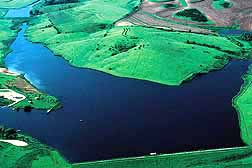This page has been archived and is being provided for reference purposes only. The page is no longer being updated, and therefore, links on the page may be invalid.
|
|
|
|
Know Your USDA Watersheds
By Don ComisDecember 4, 2008
For the first time, information collected over the past 40 years from instruments on large watersheds across the country is available online, thanks to an Agricultural Research Service (ARS) web site.
The web site, called STEWARDS (Sustaining the Earth's Watersheds, Agricultural Research Data System), has interactive maps of watersheds. The site allows users to see the topography of the watersheds and the instrument locations, as well as download data.
Jean Steiner, director of the ARS Grazinglands Research Laboratory in El Reno, Okla., came up with the idea of organizing data from watersheds nationwide into one site with a standardized format. One key purpose is to make the information available to people involved in the Conservation Effects Assessment Project (CEAP) and to expand the usefulness of the information gathered at each watershed for nationwide analyses.
CEAP began in 2003 as a multi-agency effort to quantify the environmental benefits of conservation practices used by private landowners participating in selected U.S. Department of Agriculture (USDA) conservation programs.
But the data are also crucial to others doing hydrological analyses, and to the public, especially to people living in these watersheds.
The data include information on pesticides, nitrogen and phosphorous in streams, rivers, lakes and drinking water reservoirs. The web site also has data on daily stream discharge levels, air and soil temperature and other weather data.
In addition to Steiner, the ARS team, now led by Jerry Hatfield, laboratory director at Ames, Iowa, also included Cropland CEAP Coordinator John Sadler at Columbia, Mo.; Jin-Song Chen, formerly a hydrologist at El Reno; information technology specialists Greg Wilson at Beltsville, Md., John Ross at El Reno, Teri Oster at Columbia, David James and Kevin Cole at Ames; and computer programmer Bruce Vandenberg at Fort Collins, Colo.
Two papers on STEWARDS appear in the November-December 2008 issue of the Journal of Soil and Water Conservation.
ARS is a scientific research agency in USDA.


